Petrogenesis of the Eocene Highly Fractionated Granite Porphyry with REE Tetrad Effect: An Example from Western Yunnan, Southeastern Tibetan Plateau
Abstract
:1. Introduction
2. Geological Setting and Petrography
3. Analytical Methods
3.1. Zircon U–Pb Dating and Trace Element Analysis
3.2. Zircon In Situ Lu–Hf Isotope Analyses
3.3. Whole-Rock Major and Trace Elements
3.4. Whole-Rock Sr–Nd Isotopes
4. Results
4.1. Zircon U–Pb Geochronology and Trace Elements
4.2. Geochemical and Isotopic Results
4.2.1. Major and Trace Elements
4.2.2. Sr–Nd Isotopes
| Sample | 87Rb/86Sr | 87Sr/86Sr | 2σ | (87Sr/86Sr)i | 147Sm/144Nd | 143Nd/144Nd | 2σ | (143Nd/144Nd)i | εNd(t) | TDM2 (Ma) |
|---|---|---|---|---|---|---|---|---|---|---|
| SGS-7 | 43.902 | 0.729566 | 0.000007 | 0.70837 | 0.1150 | 0.511963 | 0.000007 | 0.511937 | −12.82 | 1887 |
| SGS-8 | 64.9084 | 0.736048 | 0.000005 | 0.70470 | 0.1707 | 0.512004 | 0.000007 | 0.511966 | −12.26 | 1829 |
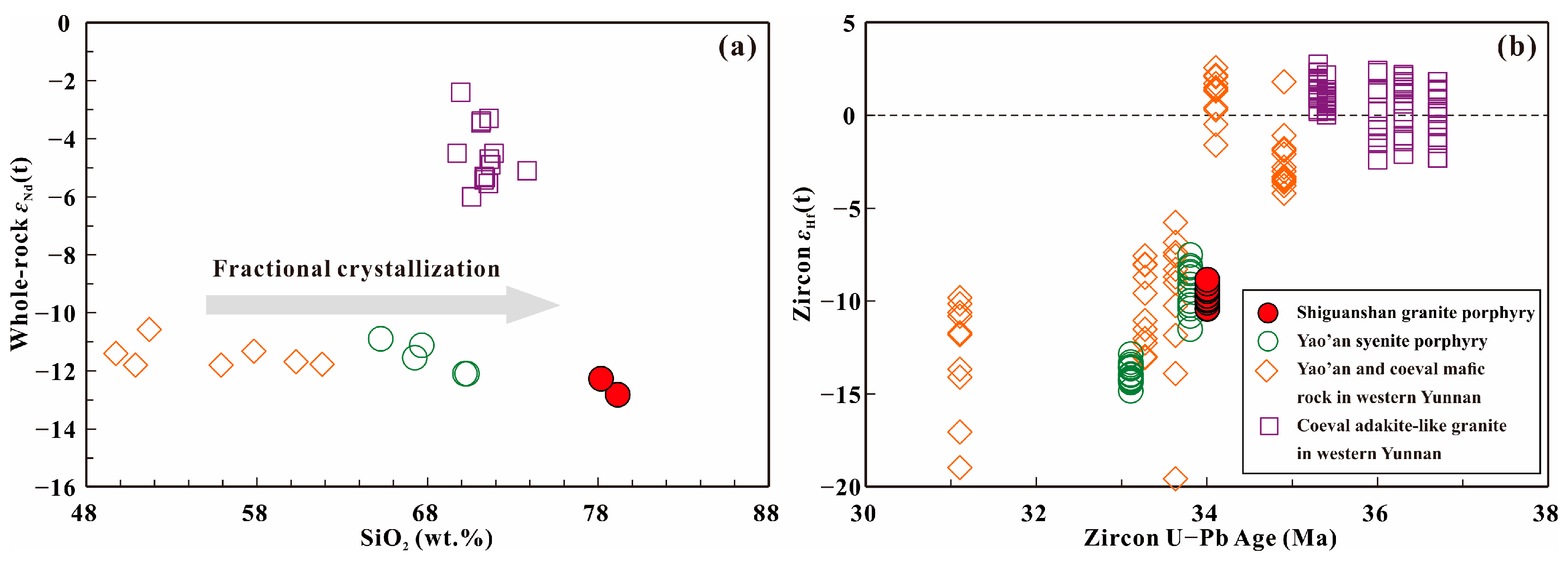
4.2.3. Zircon Lu–Hf Isotopes
5. Discussion
5.1. Age of the Shiguanshan Granite Porphyry
5.2. Petrogenesis of the Shiguanshan Granite Porphyry
5.2.1. Genetic Type: Highly Fractionated A-Type Granites
5.2.2. Fractional Crystallization Processes
5.2.3. Magma Source
5.3. The Formation Mechanism of the REE Tetrad Effect in Shiguanshan Granite Porphyries
5.4. Implications of Tectonic Setting
6. Conclusions
- (1)
- The Shiguanshan granite porphyries were emplaced at 34.0 ± 0.3 Ma, which coeval with those of the extensive Eocene–-Oligocene felsic and mafic rocks identified in western Yunnan, belonging to the post-collisional magmatic event.
- (2)
- The Shiguanshan granite porphyries are high-silica and strongly peraluminous, have high DI and zircon saturation temperatures and low MgO, and belong to highly fractionated A-type granites, which likely formed by differentiation of the coeval mantle-derived syenite porphyries. They are likely produced by the fractional crystallization process of a mineral assemblage comprising plagioclase, K-feldspar, biotite, and amphibole (in a ratio of 40:30:25:5), with fractionation degrees of 50%–55%.
- (3)
- The REE tetrad effect in the Shiguanshan granite porphyries can be attributed to the fractionation of accessory minerals (apatite, allanite, and monazite).
- (4)
- The primary magma source for the Shiguanshan granite porphyries was derived from enriched lithospheric mantle. The convective removal of the mantle lithosphere can lead to the upwelling of the asthenosphere, which in turn acts as a triggering mechanism for the formation of Shiguanshan A-type granite porphyries by providing the necessary high-melting temperature.
Supplementary Materials
Author Contributions
Funding
Data Availability Statement
Acknowledgments
Conflicts of Interest
References
- Wu, F.Y.; Liu, X.C.; Liu, Z.C.; Wang, R.C.; Xie, L.; Wang, J.M.; Ji, W.Q.; Yang, L.; Liu, C.; Khanal, G.P.; et al. Highly fractionated Himalayan leucogranites and associated rare-metal mineralization. Lithos 2020, 352–353, 105319. [Google Scholar] [CrossRef]
- Chen, Y.J.; Chen, B.; Duan, X.X.; Sun, H. Origin of highly fractionated peraluminous granites in South China: Implications for crustal anatexis and evolution. Lithos 2021, 402–403, 106145. [Google Scholar] [CrossRef]
- Chappell, B.W.; White, A.J.R. I-and S-type granites in the Lachlan Fold Belt. Trans. R. Soc. Edinb. Earth Sci. 1992, 83, 1–26. [Google Scholar] [CrossRef]
- Wang, R.C.; Wu, F.Y.; Xie, L.; Liu, X.C.; Wang, J.M.; Yang, L.; Lai, W.; Liu, C. A preliminary study of rare-metal mineralization in the Himalayan leucogranite belts, South Tibet. Sci. China Earth Sci. 2017, 60, 1655–1663. [Google Scholar] [CrossRef]
- Wu, F.Y.; Liu, X.C.; Ji, W.Q.; Wang, J.M.; Yang, L. Highly fractionated granites: Recognition and research. Sci. China Earth Sci. 2017, 60, 1201–1219. [Google Scholar] [CrossRef]
- Lee, C.A.; Morton, D.M. High silica granites: Terminal porosity and crystal settling in shallow magma chambers. Earth Planet. Sci. Lett. 2015, 409, 23–31. [Google Scholar] [CrossRef]
- Chen, J.Y.; Yang, J.H.; Zhang, J.H.; Sun, J.F.; Zhu, Y.S.; Hartung, E. Generation of Cretaceous high-silica granite by complementary crystal accumulation and silicic melt extraction in the coastal region of southeastern China. Geol. Soc. Am. Bull. 2022, 134, 201–222. [Google Scholar] [CrossRef]
- Pérez-Soba, C.; Villaseca, C. Petrogenesis of highly fractionated I-type peraluminous granites: La Pedriza pluton (Spanish Central System). Geol. Acta 2010, 8, 131–149. [Google Scholar] [CrossRef]
- Ballouard, C.; Poujol, M.; Boulvais, P.; Branquet, Y.; Tartèse, R.; Vigneresse, J.L. Nb-Ta fractionation in peraluminous granites: A marker of the magmatic-hydrothermal transition. Geology 2016, 44, 231–234. [Google Scholar] [CrossRef]
- Irber, W. The lanthanide tetrad effect and its correlation with K/Rb, Eu/Eu∗, Sr/Eu, Y/Ho, and Zr/Hf of evolving peraluminous granite suites. Geochim. Cosmochim. Acta 1999, 63, 489–508. [Google Scholar] [CrossRef]
- Dostal, J.; Kontak, D.J.; Gerel, O.; Gregory Shellnutt, J.; Fayek, M. Cretaceous ongonites (topaz-bearing albite-rich microleucogranites) from Ongon Khairkhan, Central Mongolia: Products of extreme magmatic fractionation and pervasive metasomatic fluid: Rock interaction. Lithos 2015, 236–237, 173–189. [Google Scholar] [CrossRef]
- Ballouard, C.; Massuyeau, M.; Elburg, M.A.; Tappe, S.; Viljoen, F.; Brandenburg, J.T. The magmatic and magmatic-hydrothermal evolution of felsic igneous rocks as seen through Nb-Ta geochemical fractionation, with implications for the origins of rare-metal mineralizations. Earth Sci. Rev. 2020, 203, 103115. [Google Scholar] [CrossRef]
- Veksler, I.V.; Dorfman, A.M.; Kamenetsky, M.; Dulski, P.; Dingwell, D.B. Partitioning of lanthanides and Y between immiscible silicate and fluoride melts, fluorite and cryolite and the origin of the lanthanide tetrad effect in igneous rocks. Geochim. Cosmochim. Acta 2005, 69, 2847–2860. [Google Scholar] [CrossRef]
- Peretyazhko, I.S.; Savina, E.A. Tetrad effects in the rare earth element patterns of granitoid rocks as an indicator of fluoride—Silicate liquid immiscibility in magmatic systems. Petrology 2010, 18, 514–543. [Google Scholar] [CrossRef]
- Stepanov, A.S.; Hermann, J.; Rubatto, D.; Rapp, R.P. Experimental study of monazite/melt partitioning with implications for the REE, Th and U geochemistry of crustal rocks. Chem. Geol. 2012, 300–301, 200–220. [Google Scholar] [CrossRef]
- Duc-Tin, Q.; Keppler, H. Monazite and xenotime solubility in granitic melts and the origin of the lanthanide tetrad effect. Contrib. Mineral. Petrol. 2015, 169, 8. [Google Scholar] [CrossRef]
- Wang, J.H.; Yin, A.; Harrison, T.M.; Grove, M.; Zhang, Y.Q.; Xie, G.H. A tectonic model for Cenozoic igneous activities in the eastern Indo-Asian collision zone. Earth Planet. Sci. Lett. 2001, 188, 123–133. [Google Scholar] [CrossRef]
- Hou, Z.Q.; Gao, Y.F.; Qu, X.M.; Rui, Z.Y.; Mo, X.X. Origin of adakitic intrusives generated during mid-Miocene east-west extension in southern Tibet. Earth Planet. Sci. Lett. 2004, 220, 139–155. [Google Scholar] [CrossRef]
- Lu, Y.J.; Kerrich, R.; Cawood, P.A.; McCuaig, T.C.; Hart, C.J.R.; Li, Z.X.; Hou, Z.Q.; Bagas, L. Zircon SHRIMP U-Pb geochronology of potassic felsic intrusions in western Yunnan, SW China: Constraints on the relationship of magmatism to the Jinsha suture. Gondwana Res. 2012, 22, 737–747. [Google Scholar] [CrossRef]
- Lu, Y.J.; McCuaig, T.C.; Li, Z.X.; Jourdan, F.; Hart, C.J.R.; Hou, Z.Q.; Tang, S.H. Paleogene post-collisional lamprophyres in western Yunnan, western Yangtze Craton: Mantle source and tectonic implications. Lithos 2015, 233, 139–161. [Google Scholar] [CrossRef]
- Hou, Z.Q.; Zhou, Y.; Wang, R.; Zheng, Y.C.; He, W.Y.; Zhao, M.; Weinberg, R.F. Recycling of metal-fertilized lower continental crust: Origin of non-arc Au-rich porphyry deposits at cratonic edges. Geology 2017, 45, 563–566. [Google Scholar] [CrossRef]
- Shen, Y.; Zheng, Y.C.; Hou, Z.Q.; Zhang, A.P.; Huizenga, J.M.; Wang, Z.X.; Wang, L. Petrology of the Machangqing complex in southeastern Tibet: Implications for the Genesis of potassium-rich adakite-like intrusions in collisional zones. J. Petrol. 2021, 62, egab066. [Google Scholar] [CrossRef]
- Lu, Y.J.; Kerrich, R.; Kemp, A.I.S.; McCuaig, T.C.; Hou, Z.Q.; Hart, C.J.R.; Li, Z.X.; Cawood, P.A.; Bagas, L.; Yang, Z.M.; et al. Intracontinental Eocene-Oligocene porphyry Cu mineral systems of Yunnan, western Yangtze Craton, China: Compositional characteristics, sources, and implications for continental collision metallogeny. Econ. Geol. 2013, 108, 1541–1576. [Google Scholar] [CrossRef]
- Chang, J.; Audétat, A. Post-subduction porphyry Cu magmas in the Sanjiang region of southwestern China formed by fractionation of lithospheric mantle-derived mafic magmas. Geology 2023, 51, 64–68. [Google Scholar] [CrossRef]
- Guo, Z.F.; Hertogen, J.A.N.; Liu, J.Q.; Pasteels, P.; Boven, A.; Punzalan, L.E.A.; He, H.Y.; Luo, X.J.; Zhang, W.H. Potassic Magmatism in Western Sichuan and Yunnan Provinces, SE Tibet, China: Petrological and geochemical constraints on petrogenesis. J. Petrol. 2005, 46, 33–78. [Google Scholar] [CrossRef]
- Huang, X.L.; Niu, Y.L.; Xu, Y.G.; Chen, L.L.; Yang, Q.J. Mineralogical and geochemical constraints on the petrogenesis of post-collisional potassic and ultrapotassic rocks from Western Yunnan, SW China. J. Petrol. 2010, 51, 1617–1654. [Google Scholar] [CrossRef]
- Yin, A.; Harrison, T.M. Geologic evolution of the Himalayan-Tibetan Orogen. Annu. Rev. Earth Planet. Sci. 2000, 28, 211–280. [Google Scholar] [CrossRef]
- Leech, M.L.; Singh, S.; Jain, A.K.; Klemperer, S.L.; Manickavasagam, R.M. The onset of India-Asia continental collision: Early, steep subduction required by the timing of UHP metamorphism in the western Himalaya. Earth Planet. Sci. Lett. 2005, 234, 83–97. [Google Scholar] [CrossRef]
- Zhu, D.C.; Zhao, Z.D.; Niu, Y.; Dilek, Y.; Hou, Z.Q.; Mo, X.X. The origin and pre-Cenozoic evolution of the Tibetan Plateau. Gondwana Res. 2013, 23, 1429–1454. [Google Scholar] [CrossRef]
- Deng, J.; Wang, Q.F.; Li, G.J.; Santosh, M. Cenozoic tectono-magmatic and metallogenic processes in the Sanjiang region, southwestern China. Earth Sci. Rev. 2014, 138, 268–299. [Google Scholar] [CrossRef]
- Metcalfe, I. Gondwana dispersion and Asian accretion: Tectonic and palaeogeographic evolution of eastern Tethys. J. Asian Earth Sci. 2013, 66, 1–33. [Google Scholar] [CrossRef]
- Zhao, J.H.; Zhou, M.F.; Yan, D.P.; Zheng, J.P.; Li, J.W. Reappraisal of the ages of Neoproterozoic strata in South China: No connection with the Grenvillian orogeny. Geology 2011, 39, 299–302. [Google Scholar] [CrossRef]
- Cawood, P.A.; Zhao, G.C.; Yao, J.L.; Wang, W.; Xu, Y.J.; Wang, Y.J. Reconstructing South China in Phanerozoic and Precambrian supercontinents. Earth Sci. Rev. 2018, 186, 173–194. [Google Scholar] [CrossRef]
- Zhou, M.F.; Yan, D.P.; Kennedy, A.K.; Li, Y.Q.; Ding, J. SHRIMP zircon U-Pb geochronological and geochemical evidence for Neoproterozoic arc-related magmatism along the western margin of the Yangtze Block, South China. Earth Planet. Sci. Lett. 2002, 196, 51–67. [Google Scholar] [CrossRef]
- Dong, Y.P.; Liu, X.M.; Santosh, M.; Zhang, X.N.; Chen, Q.; Yang, C.; Yang, Z. Neoproterozoic subduction tectonics of the northwestern Yangtze Block in South China: Constrains from zircon U-Pb geochronology and geochemistry of mafic intrusions in the Hannan Massif. Precambrian Res. 2011, 189, 66–90. [Google Scholar] [CrossRef]
- Li, Z.X.; Evans, D.A.D.; Halverson, G.P. Neoproterozoic glaciations in a revised global palaeogeography from the breakup of Rodinia to the assembly of Gondwanaland. Sedimentary Geol. 2013, 294, 219–232. [Google Scholar] [CrossRef]
- Dong, Y.P.; Liu, X.M.; Santosh, M.; Chen, Q.; Zhang, X.N.; Li, W.; He, D.F.; Zhang, G.W. Neoproterozoic accretionary tectonics along the northwestern margin of the Yangtze Block, China: Constraints from zircon U-Pb geochronology and geochemistry. Precambrian Res. 2012, 196–197, 247–274. [Google Scholar] [CrossRef]
- Zhao, J.H.; Li, Q.W.; Liu, H.; Wang, W. Neoproterozoic magmatism in the western and northern margins of the Yangtze Block (South China) controlled by slab subduction and subduction-transform edge propagator. Earth Sci. Rev. 2018, 187, 1–18. [Google Scholar] [CrossRef]
- Zhang, Z.C.; Mahoney, J.J.; Mao, J.W.; Wang, F.S. Geochemistry of picritic and associated basalt flows of the Western Emeishan Flood Basalt Province. J. Petrol. 2006, 47, 1997–2019. [Google Scholar] [CrossRef]
- Jian, P.; Liu, D.Y.; Kröner, A.; Zhang, Q.; Wang, Y.Z.; Sun, X.M.; Zhang, W. Devonian to Permian plate tectonic cycle of the Paleo-Tethys Orogen in southwest China (II): Insights from zircon ages of ophiolites, arc/back-arc assemblages and within-plate igneous rocks and generation of the Emeishan CFB province. Lithos 2009, 113, 767–784. [Google Scholar] [CrossRef]
- Mo, X.X.; Deng, J.F.; Lu, F.X. Volcanism and the evolution of Tethys in Sanjiang area, southwestern China. J. SE Asian Earth Sci. 1994, 9, 325–333. [Google Scholar] [CrossRef]
- Wang, X.F.; Metcalfe, I.; Jian, P.; He, L.Q.; Wang, C.S. The Jinshajiang-Ailaoshan Suture zone, China: Tectonostratigraphy, age and evolution. J. Asian Earth Sci. 2000, 18, 675–690. [Google Scholar] [CrossRef]
- Chung, S.L.; Chu, M.F.; Zhang, Y.Q.; Xie, Y.W.; Lo, C.H.; Lee, T.Y.; Lan, C.Y.; Li, X.H.; Zhang, Q.; Wang, Y.Z. Tibetan tectonic evolution inferred from spatial and temporal variations in post-collisional magmatism. Earth Sci. Rev. 2005, 68, 173–196. [Google Scholar] [CrossRef]
- Campbell, I.H.; Stepanov, A.S.; Liang, H.Y.; Allen, C.M.; Norman, M.D.; Zhang, Y.Q.; Xie, Y.W. The origin of shoshonites: New insights from the Tertiary high-potassium intrusions of eastern Tibet. Contrib. Mineral. Petrol. 2014, 167, 983–1004. [Google Scholar] [CrossRef]
- Hu, Z.C.; Li, X.H.; Luo, T.; Zhang, W.; Crowley, J.; Li, Q.L.; Ling, X.X.; Yang, C.; Li, Y.; Feng, L.P.; et al. Tanz zircon megacrysts: A new zircon reference material for the microbeam determination of U-Pb ages and Zr-O isotopes. J. Anal. At. Spectrom. 2021, 36, 2715–2734. [Google Scholar] [CrossRef]
- Zong, K.Q.; Klemd, R.; Yuan, Y.; He, Z.Y.; Guo, J.L.; Shi, X.L.; Liu, Y.S.; Hu, Z.C.; Zhang, Z.M. The assembly of Rodinia: The correlation of early Neoproterozoic (ca. 900 Ma) high-grade metamorphism and continental arc formation in the southern Beishan Orogen, southern Central Asian Orogenic Belt (CAOB). Precambrian Res. 2017, 290, 32–48. [Google Scholar] [CrossRef]
- Liu, Y.S.; Gao, S.; Hu, Z.C.; Gao, C.G.; Zong, K.Q.; Wang, D.B. Continental and oceanic crust recycling-induced melt-peridotite interactions in the Trans-North China Orogen: U-Pb dating, Hf isotopes and trace elements in zircons of mantle xenoliths. J. Petrol. 2010, 51, 537–571. [Google Scholar] [CrossRef]
- Ludwig, K.R. ISOPLOT 3.00: A Geochronological Toolkit for Microsoft Excel; Berkeley Geochronology Center Special Publication No 4; Berkeley Geochronological Center: Berkeley, CA, USA, 2003. [Google Scholar]
- Hu, Z.C.; Liu, Y.S.; Gao, S.; Liu, W.G.; Zhang, W.; Tong, X.R.; Lin, L.; Zong, K.Q.; Li, M.; Chen, H.H.; et al. Improved in situ Hf isotope ratio analysis of zircon using newly designed X skimmer cone and jet sample cone in combination with the addition of nitrogen by laser ablation multiple collector ICP-MS. J. Anal. At. Spectrom. 2012, 27, 1391–1399. [Google Scholar] [CrossRef]
- Qi, L.; Hu, J.; Gregoire, D.C. Determination of trace elements in granites by inductively coupled plasma mass spectrometry. Talanta 2000, 51, 507–513. [Google Scholar] [CrossRef]
- Lin, J.; Liu, Y.S.; Yang, Y.H.; Hu, Z.C. Calibration and correction of LA-ICP-MS and LA-MC-ICP-MS analyses for element contents and isotopic ratios. Solid Earth Sci. 2016, 1, 5–27. [Google Scholar] [CrossRef]
- Zhang, W.; Hu, Z.C. Estimation of isotopic reference values for pure materials and geological reference materials. Atomic Spectroscopy 2020, 41, 93–102. [Google Scholar] [CrossRef]
- Li, C.F.; Li, X.H.; Li, Q.L.; Guo, J.H.; Li, X.H.; Yang, Y.H. Rapid and precise determination of Sr and Nd isotopic ratios in geological samples from the same filament loading by thermal ionization mass spectrometry employing a single-step separation scheme. Anal. Chim. Acta 2012, 727, 54–60. [Google Scholar] [CrossRef]
- Hoskin, P.W.O.; Schaltegger, U. The composition of zircon and igneous and metamorphic petrogenesis. Rev. Mineral. Geochem. 2003, 53, 27–62. [Google Scholar] [CrossRef]
- Hoskin, P.W.O. Trace-element composition of hydrothermal zircon and the alteration of Hadean zircon from the Jack Hills, Australia. Geochim. Cosmochim. Acta 2005, 69, 637–648. [Google Scholar] [CrossRef]
- Sun, S.S.; McDonough, W.F. Chemical and isotopic systematics of oceanic basalts: Implications for mantle composition and processes. Geol. Soc. Lond. Spec. Publ. 1989, 42, 313–345. [Google Scholar] [CrossRef]
- Middlemost, E.A.K. Naming materials in the magma/igneous rock system. Earth Sci. Rev. 1994, 37, 215–224. [Google Scholar] [CrossRef]
- Peccerillo, A.; Taylor, S.R. Geochemistry of Eocene calc-alkaline volcanic rocks from the Kastamonu area, northern Turkey. Contrib. Mineral. Petrol. 1976, 58, 63–81. [Google Scholar] [CrossRef]
- Maniar, P.D.; Piccoli, P.M. Tectonic discrimination of granitoids. Geol. Soc. Am. Bull. 1989, 101, 635–643. [Google Scholar] [CrossRef]
- Bouseily, A.M.E.; Sokkary, A.A.E. The relation between Rb, Ba and Sr in granitic rocks. Chem. Geol. 1975, 16, 207–219. [Google Scholar] [CrossRef]
- Luo, C.H.; Zhou, Y.; Shen, Y. The geochemical characteristics and petrogenesis of the mineralized alkali-rich magmatic rock in Yao’an Au-Pb-Ag deposit, Yunnan province. Earth Sci. 2019, 44, 2063–2083, (In Chinese with English Abstract). [Google Scholar] [CrossRef]
- Xu, X.S.; Qiu, J.S. Igneous Petrology; Science Press: Beijing, China, 2010; pp. 1–346. (In Chinese) [Google Scholar]
- Nash, W.P.; Crecraft, H.R. Partition coefficients for trace elements in silicic magmas. Geochim. Cosmochim. Acta 1985, 49, 2309–2322. [Google Scholar] [CrossRef]
- Tiepolo, M.; Oberti, R.; Zanetti, A.; Vannucci, R.; Foley, S.F. Trace-element partitioning between amphibole and silicate melt. Rev. Mineral. Geochem. 2007, 67, 417–452. [Google Scholar] [CrossRef]
- Jacobsen, S.B.; Wasserburg, G.J. Sm-Nd isotopic evolution of chondrites. Earth Planet. Sci. Lett. 1980, 50, 139–155. [Google Scholar] [CrossRef]
- Goldstein, S.L.; O’Nions, R.K.; Hamilton, P.J. A Sm-Nd isotopic study of atmospheric dusts and particulates from major river systems. Earth Planet. Sci. Lett. 1984, 70, 221–236. [Google Scholar] [CrossRef]
- Peucat, J.J.; Vidal, P.; Bernard-Griffiths, J.; Condie, K.C. Sr, Nd, and Pb isotopic systematics in the Archean low- to high-grade transition zone of southern India: Syn-accretion vs. post-accretion granulites. J. Geol. 1989, 97, 537–549. [Google Scholar] [CrossRef]
- Steiger, R.H.; Jäger, E. Subcommission on geochronology: Convention on the use of decay constants in geo- and cosmochronology. Earth Planet. Sci. Lett. 1977, 36, 359–362. [Google Scholar] [CrossRef]
- Lugmair, G.W.; Marti, K. Lunar initial 143Nd/144Nd: Differential evolution of the lunar crust and mantle. Earth Planet. Sci. Lett. 1978, 39, 349–357. [Google Scholar] [CrossRef]
- He, W.Y.; Mo, X.X.; Yang, L.Q.; Xing, Y.L.; Dong, G.C.; Yang, Z.; Gao, X.; Bao, X.S. Origin of the Eocene porphyries and mafic microgranular enclaves from the Beiya porphyry Au polymetallic deposit, western Yunnan, China: Implications for magma mixing/mingling and mineralization. Gondwana Res. 2016, 40, 230–248. [Google Scholar] [CrossRef]
- Yan, Q.G.; Jiang, X.J.; Li, C.; Zhou, L.M.; Wang, Z.Q.; Sultan, B.S.; Qu, W.J.; Du, A.D. Geodynamic background of intracontinental Cenozoic alkaline volcanic rocks in Laojiezi, western Yangtze Craton: Constraints from Sr-Nd-Hf-O isotopes. Acta Geol. Sin. 2018, 92, 2098–2119. [Google Scholar]
- Yan, Q.G.; Guo, Z.L.; Li, C.; Jiang, X.J.; Wang, Z.Q.; Li, Y.D. Zircon LA-ICP-MS U-Pb geochronology and Hf isotopes of lamprophyre in Gan’gou gold deposit, Yao’an County, Central Yunnan Province. Miner. Depos. 2019, 38, 526–540, (In Chinese with English Abstract). [Google Scholar] [CrossRef]
- Blichert-Toft, J.; Albarède, F. The Lu-Hf isotope geochemistry of chondrites and the evolution of the mantle–crust system. Earth Planet. Sci. Lett. 1997, 148, 243–258. [Google Scholar] [CrossRef]
- Griffin, W.L.; Pearson, N.J.; Belousova, E.; Jackson, S.E.; van Achterbergh, E.; O’Reilly, S.Y.; Shee, S.R. The Hf isotope composition of cratonic mantle: LAM-MC-ICPMS analysis of zircon megacrysts in kimberlites. Geochim. Cosmochim. Acta 2000, 64, 133–147. [Google Scholar] [CrossRef]
- Söderlund, U.; Patchett, P.J.; Vervoort, J.D.; Isachsen, C.E. The 176Lu decay constant determined by Lu-Hf and U-Pb isotope systematics of Precambrian mafic intrusions. Earth Planet. Sci. Lett. 2004, 219, 311–324. [Google Scholar] [CrossRef]
- Griffin, W.L.; Wang, X.; Jackson, S.E.; Pearson, N.J.; O’Reilly, S.Y.; Xu, X.S.; Zhou, X.M. Zircon chemistry and magma mixing, SE China: In-situ analysis of Hf isotopes, Tonglu and Pingtan igneous complexes. Lithos 2002, 61, 237–269. [Google Scholar] [CrossRef]
- Chappell, B.W.; White, A.J.R. Two contrasting granite types: 25 years later. Aust. J. Earth Sci. 2001, 48, 489–499. [Google Scholar] [CrossRef]
- Wu, F.Y.; Li, X.H.; Yang, J.H.; Zheng, Y.F. Discussions on the petrogenesis of granites. Acta Petrol. Sin. 2007, 23, 1217–1238, (In Chinese with English Abstract). [Google Scholar]
- Watson, E.B.; Harrison, T.M. Zircon saturation revisited: Temperature and composition effects in a variety of crustal magma types. Earth Planet Sci. Lett. 1983, 64, 295–304. [Google Scholar] [CrossRef]
- Miller, C.F.; McDowell, S.M.; Mapes, R.W. Hot and cold granites? Implications of zircon saturation temperatures and preservation of inheritance. Geology 2003, 31, 529–532. [Google Scholar] [CrossRef]
- Eby, G. Chemical subdivision of the A-type granitoids: Petrogenetic and tectonic implication. Geology 1992, 20, 641–644. [Google Scholar] [CrossRef]
- Whalen, J.B.; Currie, K.L.; Chappell, B.W. A-type granites: Geochemical characteristics, discrimination and petrogenesis. Contrib. Mineral. Petrol. 1987, 95, 407–419. [Google Scholar] [CrossRef]
- Shuai, X.; Li, S.M.; Zhu, D.C.; Wang, Q.; Zhang, L.L.; Zhao, Z.D. Tetrad effect of rare earth elements caused by fractional crystallization in high-silica granites: An example from central Tibet. Lithos 2021, 384–385, 105968. [Google Scholar] [CrossRef]
- Landenberger, B.; Collins, W.J. Derivation of A-type granites from a dehydrated charnockitic lower crust: Evidence from the Chaelundi Complex, eastern Australia. J. Petrol. 1996, 37, 145–170. [Google Scholar] [CrossRef]
- Zhu, R.Z.; Lai, S.C.; Fowler, M.; Xie, J.C.; Glynn, S.M. A microcosm of modern crust formation: Evidence from zircon ages, Hf-O and Nd-Sr isotopes and bulk geochemistry of the Menglian Batholith, SE Tibet. Chem. Geol. 2023, 618, 121276. [Google Scholar] [CrossRef]
- Turner, S.P.; Foden, J.D.; Morrison, R.S. Derivation of some A-type magmas by fractionation of basaltic magma: An example from the Padthaway Ridge, South Australia. Lithos 1992, 28, 151–179. [Google Scholar] [CrossRef]
- Litvinovsky, B.A.; Jahn, B.M.; Zanvilevich, A.N.; Saunders, A.; Poulain, S.; Kuzmin, D.V.; Reichow, M.K.; Titov, A.V. Petrogenesis of syenite–granite suites from the Bryansky Complex (Transbaikalia, Russia): Implications for the origin of A-type granitoid magmas. Chem. Geol. 2002, 16, 105–133. [Google Scholar] [CrossRef]
- Baker, M.B.; Hirschmann, M.M.; Ghiorso, M.S.; Stolper, E.M. Compositions of near-solidus predictive melts from experiments and thermodynamic calculations. Nature 1995, 375, 308–311. [Google Scholar] [CrossRef]
- Woodhead, J.; Hergt, J.; Greig, A.; Edwards, L. Subduction zone Hf-anomalies: Mantle messenger, melting artefact or crustal process? Earth Planet. Sci. Lett. 2011, 304, 231–239. [Google Scholar] [CrossRef]
- Li, X.; Li, W.; Wang, X.; Li, Q.; Liu, Y.; Tang, G. Role of mantle-derived magma in genesis of early Yanshanian granites in the Nanling Range, South China: In situ zircon Hf–O isotopic constraints. Sci. China Earth Sci. 2009, 52, 1262–1278. [Google Scholar] [CrossRef]
- Bau, M. Controls on the fractionation of isovalent trace elements in magmatic and aqueous systems: Evidence from Y/Ho, Zr/Hf, and lanthanide tetrad effect. Contrib. Mineral. Petrol. 1996, 123, 323–333. [Google Scholar] [CrossRef]
- Monecke, T.; Kempe, U.; Trinkler, M.; Thomas, R.; Dulski, P.; Wagner, T. Unusual rare earth element fractionation in a tin-bearing magmatic-hydrothermal system. Geology 2011, 39, 295–298. [Google Scholar] [CrossRef]
- Lee, H.M.; Lee, S.G.; Kim, H.; Lee, J.I.; Lee, M.J. REE tetrad effect and Sr-Nd isotope systematics of A-type Pirrit Hills granite from West Antarctica. Minerals 2022, 11, 792. [Google Scholar] [CrossRef]
- Stepanov, A.S.; Hermann, J. Fractionation of Nb and Ta by biotite and phengite: Implications for the “missing Nb paradox”. Geology 2013, 41, 303–306. [Google Scholar] [CrossRef]
- Chen, B.; Gu, H.O.; Chen, Y.; Sun, K.; Chen, W. Lithium isotope behavior during partial melting of metapelites from the Jiangnan Orogen, South China: Implications for the origin of REE tetrad effect of F-rich granite and associated rare-metal mineralization. Chem. Geol. 2018, 483, 372–384. [Google Scholar] [CrossRef]
- Mahood, G.A.; Hildreth, W. Large partition coefficients for trace elements in high-silica rhyolites. Geochim. Cosmochim. Acta 1983, 47, 11–30. [Google Scholar] [CrossRef]
- Ward, C.D.; McArthur, J.; Walsh, J.N. Rare earth element behavior during evolution and alteration of the Dartmoor granite, SW England. J. Petrol. 1992, 33, 785–815. [Google Scholar] [CrossRef]
- Shimizu, K.; Liang, Y.; Sun, C.G.; Jackson, C.R.M.; Saal, A.E. Parameterized lattice strain models for REE partitioning between amphibole and silicate melt. Am. Mineral. 2017, 102, 2254–2267. [Google Scholar] [CrossRef]
- Wu, F.Y.; Sun, D.Y.; Li, H.M.; Jahn, B.M.; Wilde, S. A-type granites in northeastern China: Age and geochemical constraints on their petrogenesis. Chem. Geol. 2002, 187, 143–173. [Google Scholar] [CrossRef]
- Whalen, J.B.; Jenner, G.A.; Longstaffe, F.J.; Robert, F.; Gariepy, C. Geochemical and isotopic (O, Nd, Pb and Sr) constraints on A-type granite petrogenesis based on the Topsails igneous suite, Newfoundland Appalachians. J. Petrol. 1996, 37, 1463–1489. [Google Scholar] [CrossRef]
- Capitanio, F.A.; Morra, G.; Goes, S.; Weinberg, R.F.; Moresi, L. India–Asia convergence driven by the subduction of the Greater Indian continent. Nature Geosci. 2010, 3, 136–139. [Google Scholar] [CrossRef]
- Hou, Z.Q.; Ma, H.W.; Zaw, K.; Zhang, Y.Q.; Wang, M.J.; Wang, Z.; Pan, G.T.; Tang, R.L. The Himalayan Yulong porphyry copper belt: Product of large-scale strike-slip faulting in eastern Tibet. Econ. Geol. 2003, 98, 125–145. [Google Scholar] [CrossRef]
- Clemens, J.D. S-type granitic magmas-petrogenetic issues, models and evidence. Earth Sci. Rev. 2003, 61, 1–18. [Google Scholar] [CrossRef]
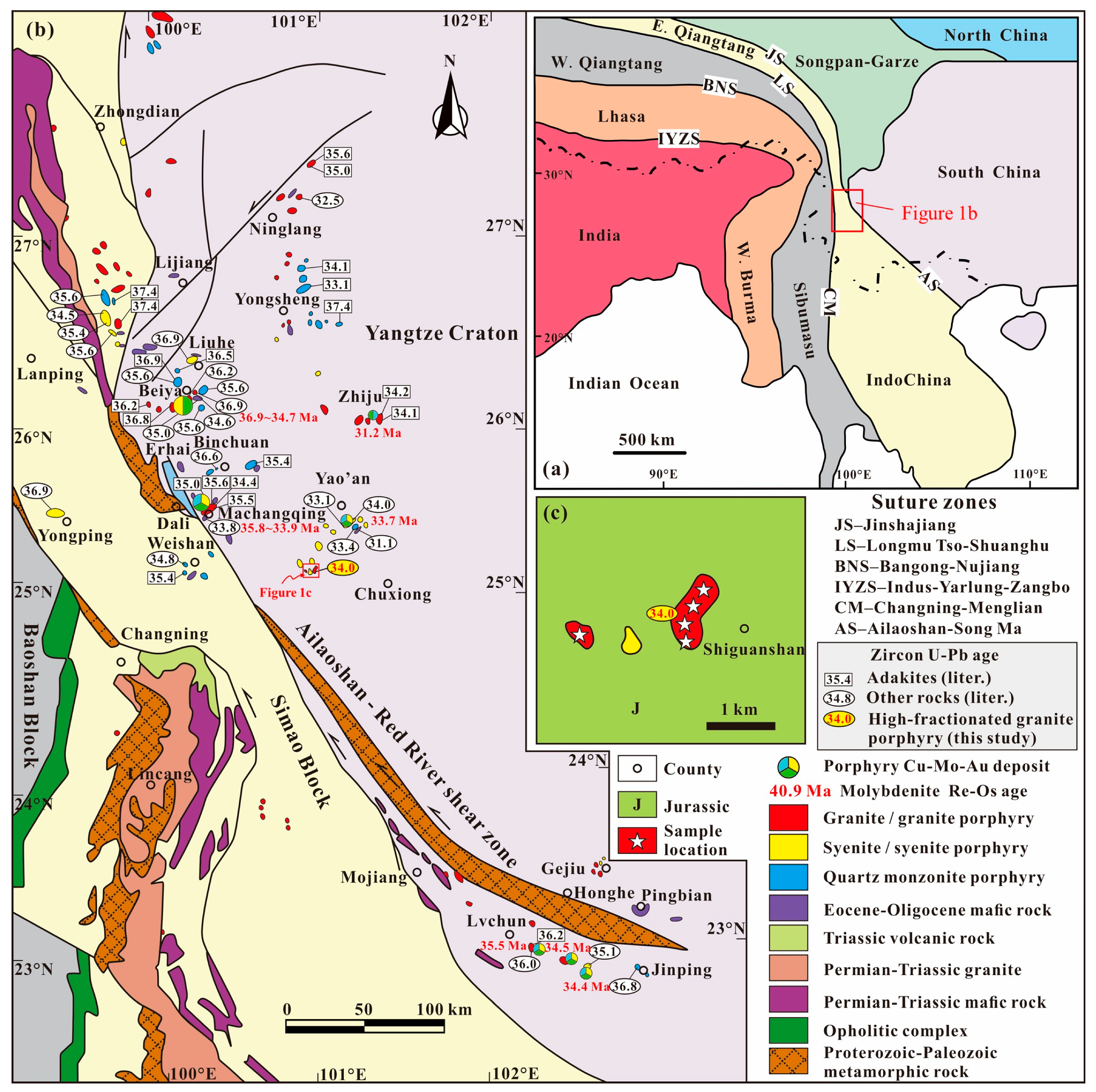
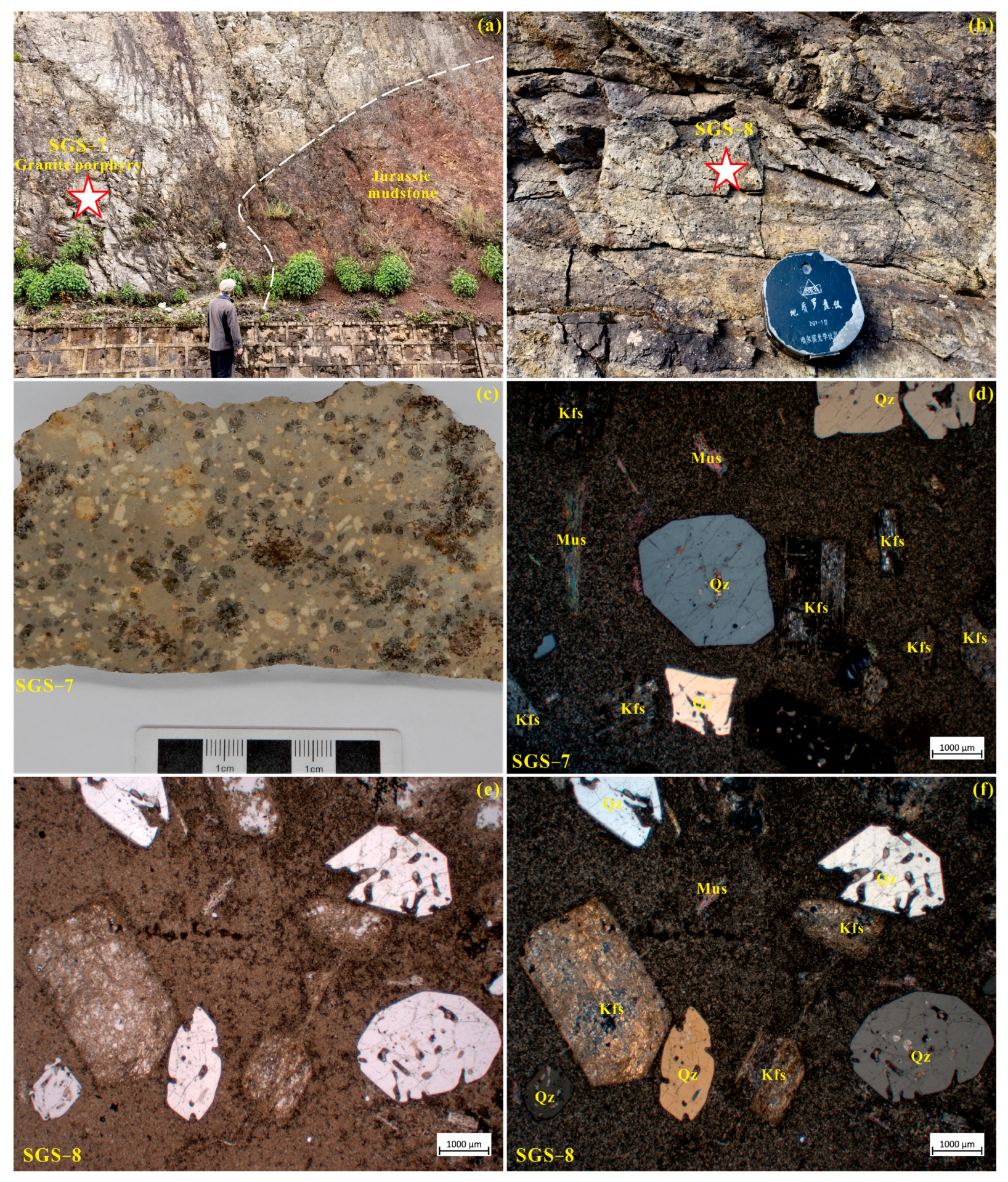


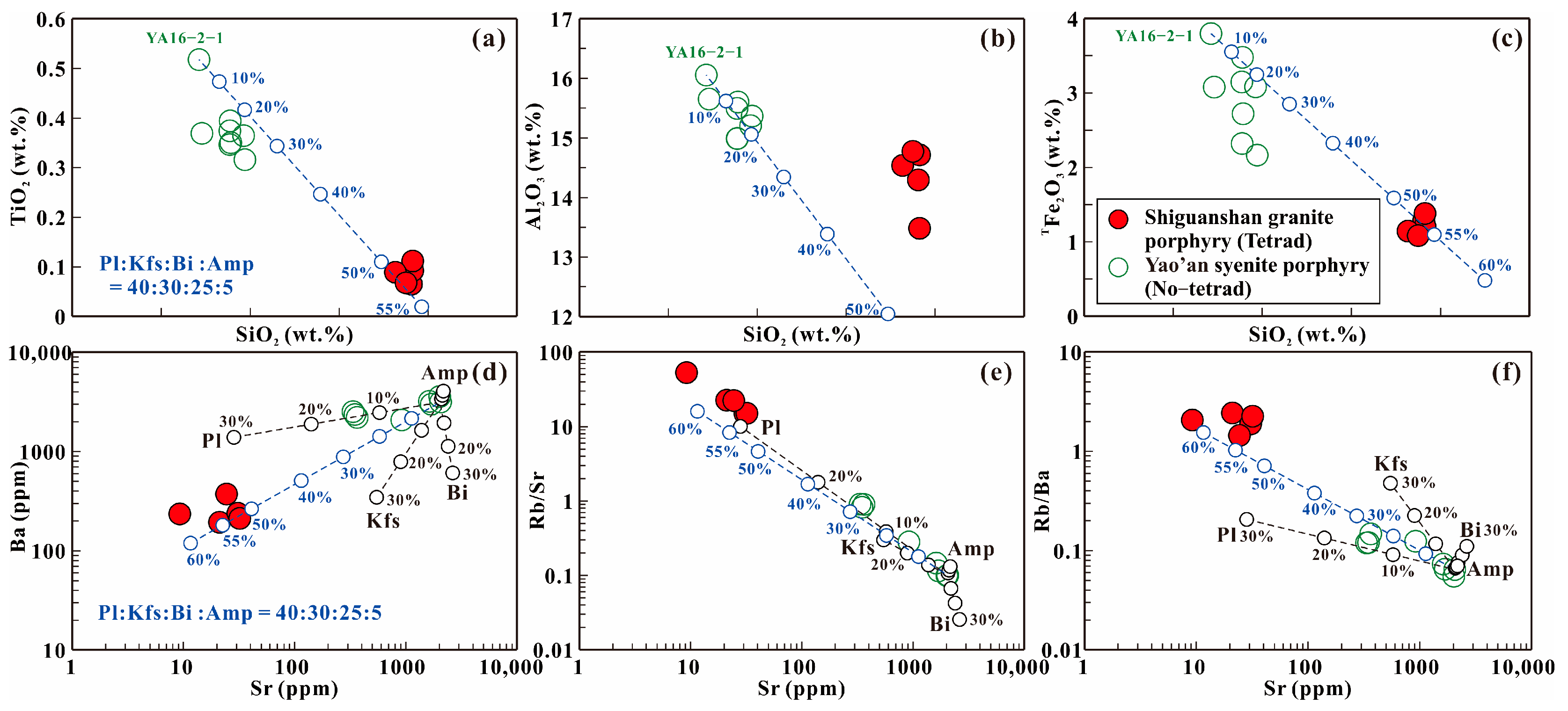


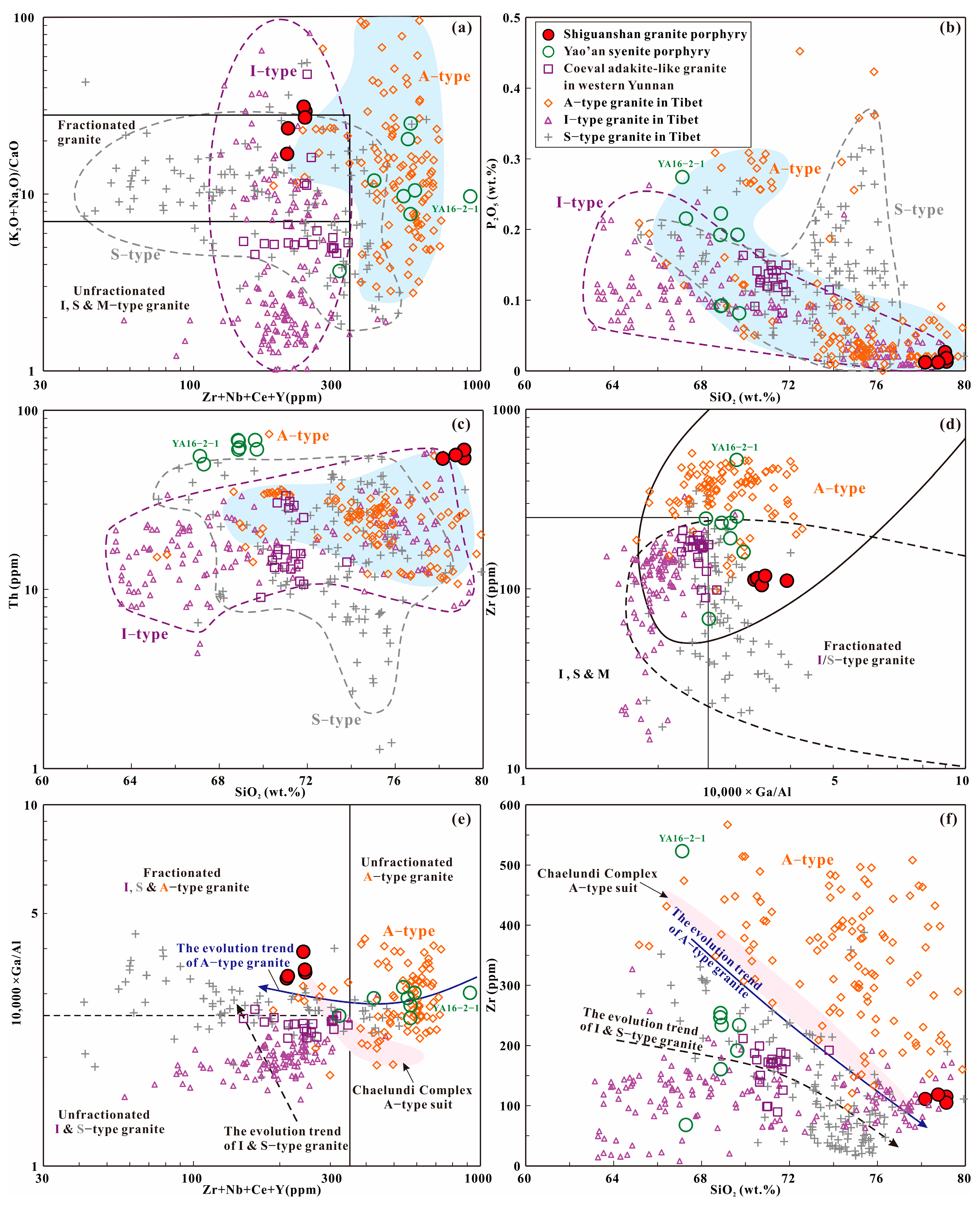
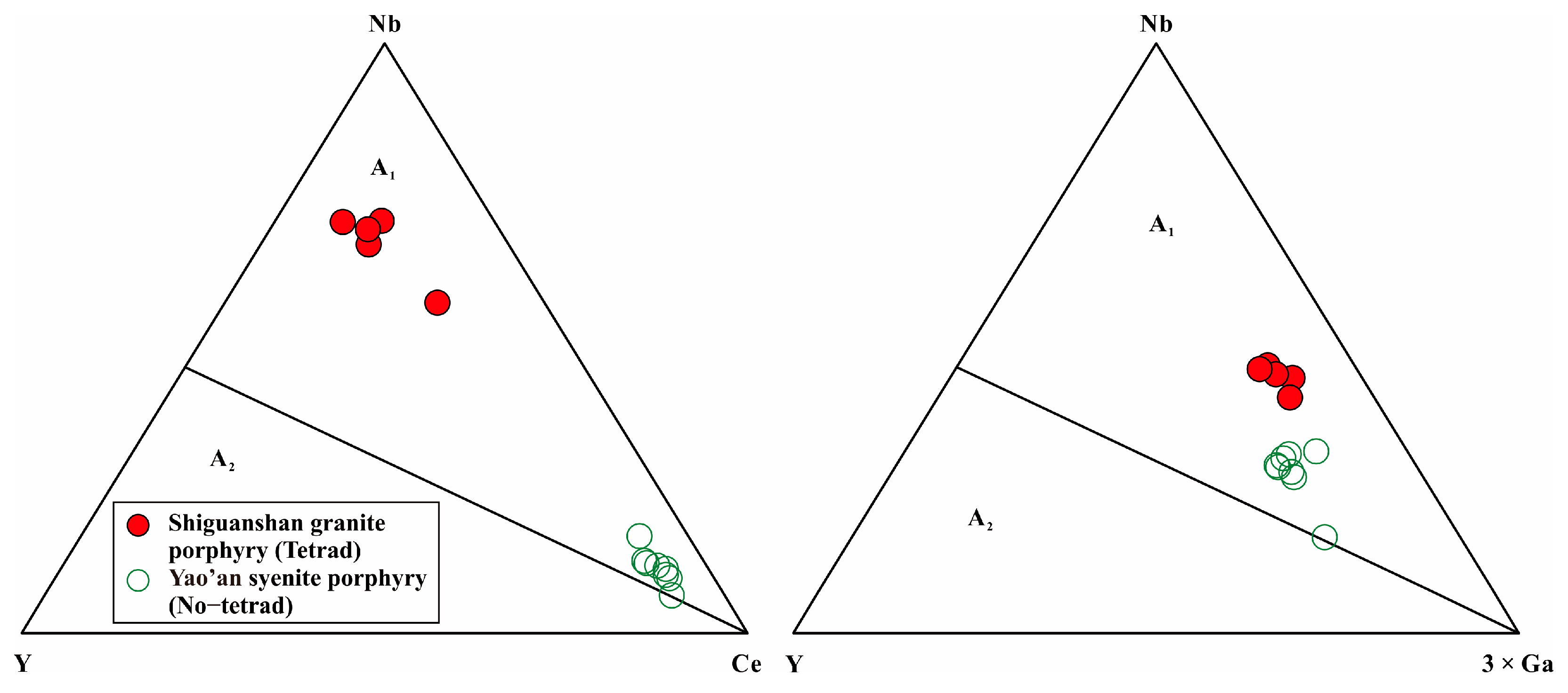

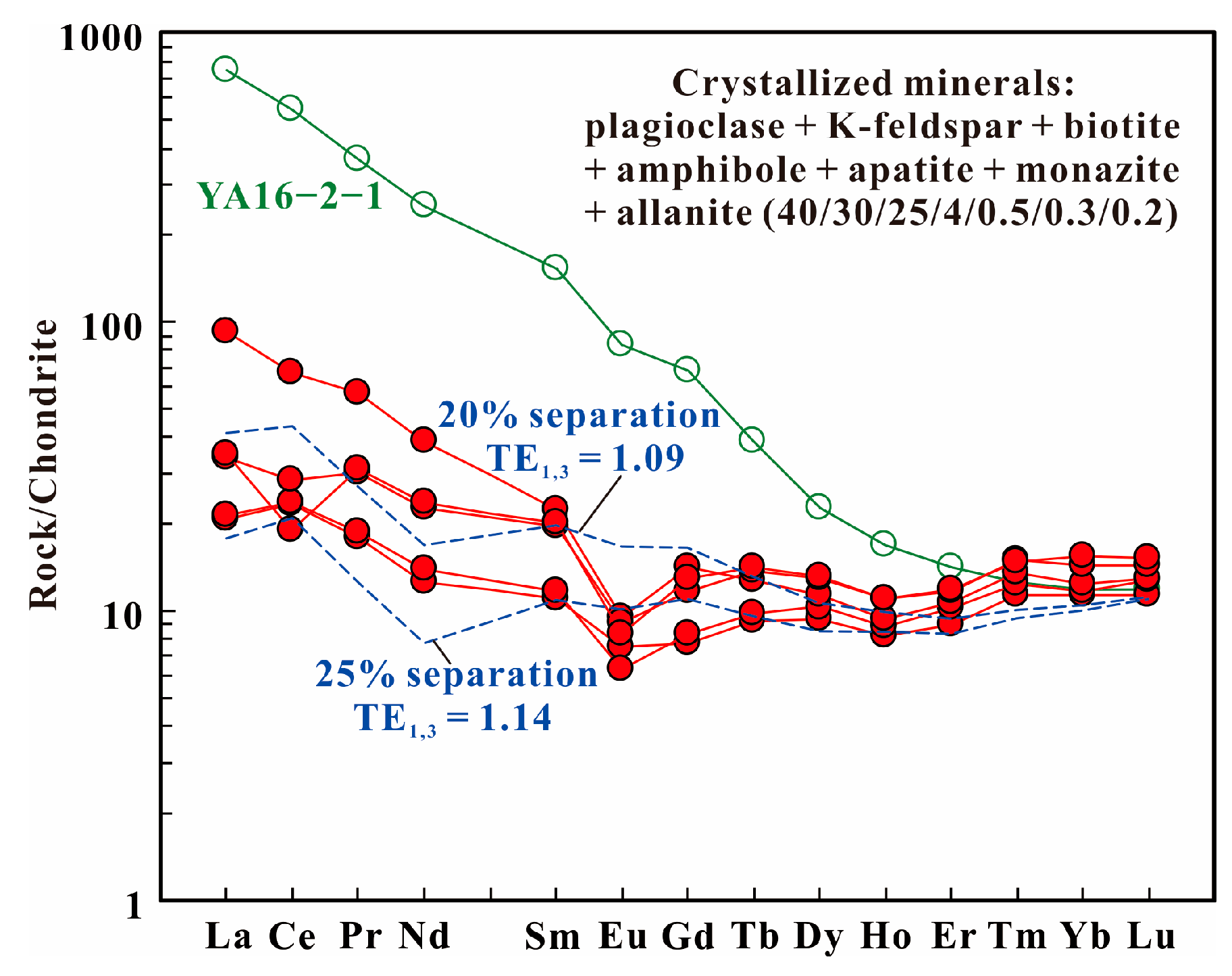
| Spot | 176Yb/177Hf | 176Lu/177Hf | 176Hf/177Hf | 1σ | 176Hf/177Hfi | εHf(0) | εHf(t) | TDM1(Ma) | TDM2(Ma) | fLu/Hf |
|---|---|---|---|---|---|---|---|---|---|---|
| 1 | 0.033915 | 0.001009 | 0.282477 | 0.000015 | 0.282476 | −10.4 | −9.7 | 1095 | 1729 | −0.97 |
| 2 | 0.046189 | 0.001395 | 0.282470 | 0.000017 | 0.282469 | −10.7 | −10.0 | 1116 | 1745 | −0.96 |
| 3 | 0.028756 | 0.000891 | 0.282483 | 0.000012 | 0.282483 | −10.2 | −9.5 | 1083 | 1715 | −0.97 |
| 4 | 0.041486 | 0.001294 | 0.282456 | 0.000017 | 0.282456 | −11.2 | −10.4 | 1132 | 1775 | −0.96 |
| 5 | 0.038821 | 0.001179 | 0.282458 | 0.000012 | 0.282457 | −11.1 | −10.4 | 1127 | 1773 | −0.96 |
| 6 | 0.046810 | 0.001398 | 0.282502 | 0.000013 | 0.282501 | −9.6 | −8.8 | 1071 | 1674 | −0.96 |
| 7 | 0.035780 | 0.001057 | 0.282467 | 0.000012 | 0.282466 | −10.8 | −10.1 | 1111 | 1753 | −0.97 |
| 8 | 0.022749 | 0.000704 | 0.282487 | 0.000013 | 0.282487 | −10.1 | −9.3 | 1072 | 1706 | −0.98 |
| 9 | 0.030921 | 0.000919 | 0.282472 | 0.000012 | 0.282471 | −10.6 | −9.9 | 1100 | 1741 | −0.97 |
| 10 | 0.034426 | 0.001041 | 0.282487 | 0.000014 | 0.282486 | −10.1 | −9.4 | 1082 | 1707 | −0.97 |
| 11 | 0.042083 | 0.001310 | 0.282478 | 0.000013 | 0.282477 | −10.4 | −9.7 | 1102 | 1727 | −0.96 |
| 12 | 0.046712 | 0.001464 | 0.282496 | 0.000016 | 0.282495 | −9.8 | −9.1 | 1081 | 1687 | −0.96 |
Disclaimer/Publisher’s Note: The statements, opinions and data contained in all publications are solely those of the individual author(s) and contributor(s) and not of MDPI and/or the editor(s). MDPI and/or the editor(s) disclaim responsibility for any injury to people or property resulting from any ideas, methods, instructions or products referred to in the content. |
© 2023 by the authors. Licensee MDPI, Basel, Switzerland. This article is an open access article distributed under the terms and conditions of the Creative Commons Attribution (CC BY) license (https://creativecommons.org/licenses/by/4.0/).
Share and Cite
Yang, H.; Wu, P.; Liu, A.; Wang, F. Petrogenesis of the Eocene Highly Fractionated Granite Porphyry with REE Tetrad Effect: An Example from Western Yunnan, Southeastern Tibetan Plateau. Minerals 2023, 13, 1390. https://doi.org/10.3390/min13111390
Yang H, Wu P, Liu A, Wang F. Petrogenesis of the Eocene Highly Fractionated Granite Porphyry with REE Tetrad Effect: An Example from Western Yunnan, Southeastern Tibetan Plateau. Minerals. 2023; 13(11):1390. https://doi.org/10.3390/min13111390
Chicago/Turabian StyleYang, Hang, Peng Wu, Anlin Liu, and Feng Wang. 2023. "Petrogenesis of the Eocene Highly Fractionated Granite Porphyry with REE Tetrad Effect: An Example from Western Yunnan, Southeastern Tibetan Plateau" Minerals 13, no. 11: 1390. https://doi.org/10.3390/min13111390
APA StyleYang, H., Wu, P., Liu, A., & Wang, F. (2023). Petrogenesis of the Eocene Highly Fractionated Granite Porphyry with REE Tetrad Effect: An Example from Western Yunnan, Southeastern Tibetan Plateau. Minerals, 13(11), 1390. https://doi.org/10.3390/min13111390





